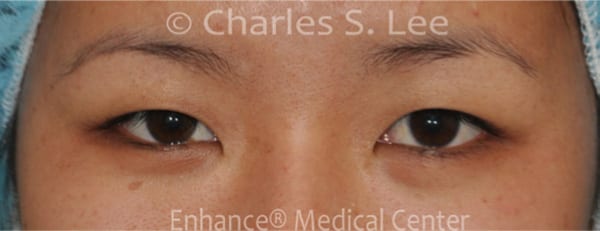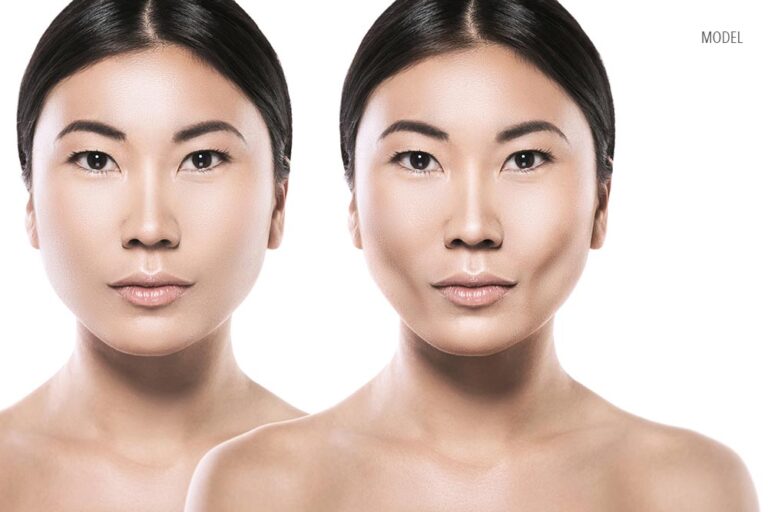(Adapted from Masters Topic presentation, Vegas Cosmetic Symposium 2011).
In the best of hands, it is possible that the eyelids can end up uneven. Why does this happen?
Certainly it can be the lack of experience or training on the part of the surgeon.
But there are many factors that make certain eyelids easier to work on than others.
First: Your best chances for a symmetric result are if you are symmetric to begin with.
To repeat, the best chance that your eyes will turn out symmetric after surgery is if your eyes are symmetric prior to surgery. Unfortunately, this is an exception rather than the rule.

 This patient’s eyes are evaluated for symmetry in the position of the eyelid margin (where the eyelashes rest) compared to the pupil (or the reflection of the camera flash). Because her eyelid position is symmetric pre-surgery, a symmetric result after surgery is expected. However, most patients have varying degrees of asymmetry in the position of the lid margin.
This patient’s eyes are evaluated for symmetry in the position of the eyelid margin (where the eyelashes rest) compared to the pupil (or the reflection of the camera flash). Because her eyelid position is symmetric pre-surgery, a symmetric result after surgery is expected. However, most patients have varying degrees of asymmetry in the position of the lid margin.
The most common risk factor for an asymmetric outcome from surgery is when there is a preexisting asymmetric lid position. What this means is that the upper eyelid margin on one eye is slightly lower than the other eye when looking directly forward.
 We use the term “ptosis” or droop, to describe this condition. Most people have minor degrees of it. The degree of ptosis is measured by the distance between the camera-flash reflection to the lid margin.
We use the term “ptosis” or droop, to describe this condition. Most people have minor degrees of it. The degree of ptosis is measured by the distance between the camera-flash reflection to the lid margin.
 The red markings in the photo above show that the patient’s right eye as a 1mm distance from flash to lid margin; the left eye has a 2mm distance. The normal distance should be 3mm to 4mm. So this patient has ptosis in both eyes, with a greater degree of ptosis on the right. When performing eyelid crease surgery, the vertical size differences need to be corrected as part of the operation. The droopy, ptotic eye is enlarged by tightening the internal muscle prior to placing the eyelid crease.
The red markings in the photo above show that the patient’s right eye as a 1mm distance from flash to lid margin; the left eye has a 2mm distance. The normal distance should be 3mm to 4mm. So this patient has ptosis in both eyes, with a greater degree of ptosis on the right. When performing eyelid crease surgery, the vertical size differences need to be corrected as part of the operation. The droopy, ptotic eye is enlarged by tightening the internal muscle prior to placing the eyelid crease.

 Right ptosis correction with inner fold correction (inner epi, or medial epicanthoplasty). Note that the brow will frequently drop lower and in some cases, a browlift even at a young age can improve the appearance of the eye area.Mild cases of ptosis can be corrected relatively easily, but as the more severe cases can require some minor adjustment after full healing due to the inexact nature of the procedure.
Right ptosis correction with inner fold correction (inner epi, or medial epicanthoplasty). Note that the brow will frequently drop lower and in some cases, a browlift even at a young age can improve the appearance of the eye area.Mild cases of ptosis can be corrected relatively easily, but as the more severe cases can require some minor adjustment after full healing due to the inexact nature of the procedure.
In many cases, the differences in eye size are quite subtle and easily missed, even by experienced surgeons. In the next case, the patient had right eye ptosis worse than the left. This would be quite difficult to detect pre-surgically. The indicators of ptosis were: 1) that the resting level of both lids is slightly low; 2) the right brow is slightly higher than the left. This is caused by the right brow “working” harder to assist the weaker, right eye; 3) the patient tends to tilt the head slightly in order to “even out” the lid position; 4) and the existence of multiple folds on the right eye.

 This patient demonstrates a subtle bilateral ptosis, right worse than left. Correction required tightening of the internal muscles, with greater correction on the right. The inner and outer corners were also divided to increase the amount of cornea show. Note that the head no longer tilts and the brow position is more symmetric.When ptosis goes unrecognized, then an uneven result is inevitable. The double eyelid crease exaggerates the preexisting discrepancy between the two eyes. In many cases, a minor readjustment will correct the size differences.
This patient demonstrates a subtle bilateral ptosis, right worse than left. Correction required tightening of the internal muscles, with greater correction on the right. The inner and outer corners were also divided to increase the amount of cornea show. Note that the head no longer tilts and the brow position is more symmetric.When ptosis goes unrecognized, then an uneven result is inevitable. The double eyelid crease exaggerates the preexisting discrepancy between the two eyes. In many cases, a minor readjustment will correct the size differences.
Here is a case of ptosis which is can easily be missed by even an experienced surgeon (some would not call this ptosis).
 The eyes appear to have good lid position relative to the pupil, with the patient’s left eye very slightly lower than the left (approximately 0.5mm).
The eyes appear to have good lid position relative to the pupil, with the patient’s left eye very slightly lower than the left (approximately 0.5mm).
This patient in her young twenties requested Asian eyelid surgery in order to look more attractive and did not want a change in the crease size. The patient recognizes that there is something about the eyes that could be more attractive without being able to describe precisely describing the problem.
It would not be unusual to have a surgeon suggest fillers or fat grafting to the hollow area. However, that would be a treatment based on a misdiagnosis. In this case, the patient has compensated for her ptosis by straining her brow upward.

 Three weeks after Asian double eyelid surgery with bilateral ptosis repair, left greater than right, in a patient in her early 20’s.Note the three week post op result. Although the crease size is approximately the same, the brow position is much improved as is the symmetry in the lid position. She appears more alert and more relaxed.
Three weeks after Asian double eyelid surgery with bilateral ptosis repair, left greater than right, in a patient in her early 20’s.Note the three week post op result. Although the crease size is approximately the same, the brow position is much improved as is the symmetry in the lid position. She appears more alert and more relaxed.
This patient in her latter 20’s underwent a DST (double sutures and twist) method by the plastic surgeon who coined this term (and from whom I learned the procedure). She had an excellent result. Eight years after surgery, she developed multiple folds on the left eye and requested correction.
 I was somewhat tempted to re-perform the DST procedure, but noted 1. Multiple folds, which suggest that the internal muscle may need adjustment; and 2. Her tilted head position, a second clue that the internal muscle may need adjustment.
I was somewhat tempted to re-perform the DST procedure, but noted 1. Multiple folds, which suggest that the internal muscle may need adjustment; and 2. Her tilted head position, a second clue that the internal muscle may need adjustment.
 Three weeks after DST to Flowers’ anchor incision Asian eyelid surgery with internal muscle adjustment. Note the improvement in the head tilt and the slight drop in brow position.The patient underwent an anchor incision Asian double eyelid surgery with internal muscle adjustment. She is still slightly puffy but certainly able to resume normal activities.
Three weeks after DST to Flowers’ anchor incision Asian eyelid surgery with internal muscle adjustment. Note the improvement in the head tilt and the slight drop in brow position.The patient underwent an anchor incision Asian double eyelid surgery with internal muscle adjustment. She is still slightly puffy but certainly able to resume normal activities.
In younger patients, a drop in brow position resulting from ptosis repair is frequently desirable. It removes the “surprised” or strained appearance. However, it is not at all unusual for the brow to descend much lower than is aesthetically pleasing after ptosis repair. Such patients would benefit from a browlift, which I perform through the upper lid incision. There is no minimum age restriction on a browlift – anyone whose brow position lies lower than ideal is a potential candidate.
In some cases, an opposite situation can exist. Instead of a droopy eye, one eye can slightly over-open, i.e., a retraction.
Slight retraction of the eye can sometimes represent early stages of an overactive thyroid gland and an evaluation may be in order.
Thus it is possible that a perfectly performed eyelid surgery can eventually look uneven or change in size with certain medical conditions such as thyroid disease.
The factors that play in obtaining a good result are a combination of the surgeon’s skill, the patient’s anatomy and the patient’s health and healing characteristics.






